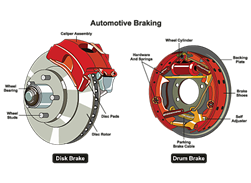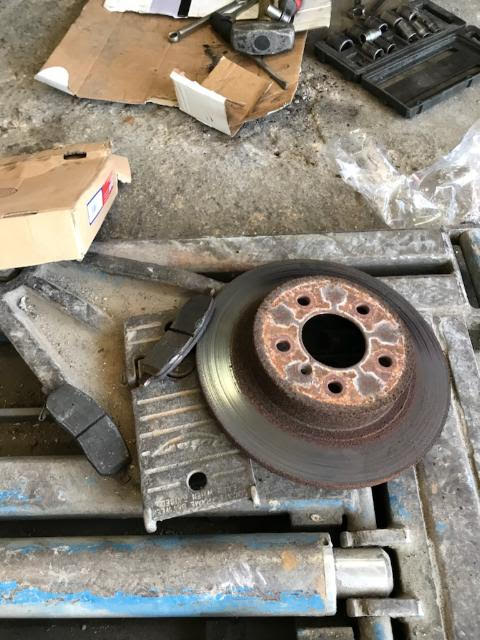It might be helpful for you to see what the brakes on your vehicle look like. It is certainly worth your time to find out why you need to replace certain brake parts and/or to obtain brake service. Let’s face it – some auto services can be expensive. So, not only is it smart to find out more about your brakes and whether or not they might need some type of repair, your life and the safety of others, could depend on it!
All your brake parts work together to perform one important and vital function: safe and effective stopping power. Here’s a quick lesson: When you step on the brake pedal, you trigger the cylinder that delivers brake fluid to the calipers that then engage your brake pads. Your brake pads then apply pressure to the rotors, creating enough friction to stop your car. It’s all connected.
In most vehicles, brakes use hydraulic pressure to shift the weight of your foot to the wheels, thereby stopping your car. There are a few different brake systems including:
- Disc brakes and
- Drum brakes
Each brake system works differently.

How Disc Brakes Work
The disc brake system takes the force of your foot and shifts it to the brakes. This type of system has a disc (rotor) that rotates and a pad (made of a friction material) that is fitted to the caliper that clamps onto that disc and applies pressure (with a piston) and slows down the rotation of the disc, thereby slowing & eventually stopping the vehicle.
Thanks to the hydraulics used in this system, the force that’s ultimately applied to each brake is greater than the force of the driver’s foot. That force has enough power to stop the vehicle. Of course, this system is more complicated than that, but those are the basics of a disc brake system.
How Drum Brakes Work
Some vehicles have drum brakes instead of disc brakes on the back wheels. These brakes feature “shoes” inside of a drum. They are fitted with brake linings (a friction material) that press against the drums from the inside – generating braking force to decelerate and stop.
Over time, brake pads wear thin, which means they won’t generate enough heat from friction and this decreases their ability to quickly stop the vehicle. If they are unable to stop quickly, the distance required to do so will increase and as you can imagine, causes all sorts of problems. Eventually, the pads wear out completely, and you have a nightmare on your hands.
Brake pads should probably be replaced about every 50,000 miles. However, every car is different and there are a number of warning signs that can indicate you may need new brake pads sooner.
One of the signs of worn brake pads is when you hear a screeching noise. This is because brake pads are designed to produce a high-pitched warning siren when the pads are almost gone. That irritating noise is how you know it’s time to replace your pads. A thin layer of rust over your brake pads can also make a similar squeaking noise, but that will usually go away after you use your brakes a couple of times. If the noise stays, be sure to get your brakes checked right away. If you let the problem go, and the persistent squeaking turns into grinding, you’ll probably have to get new (more costly) rotors along with new brake pads.
In some vehicle models, there is a sensor on the brake pad that will trigger when the pad becomes worn down. If your brake light turns on, you’ll need a professional like Alpha Omega Tire & Auto to take a look at your pads and determine how soon to replace them.
When it comes to replacing your brake pads and rotors, you generally have 3 options to choose from 1) replace just the brake pads, 2) replace the brake pads and recoat the rotors, or 3) replace both the pads and rotors together. How often you need to replace your rotors depends on a lot of things, for example, the quality and durability of the original brake mechanisms and where, when, and how often you drive your vehicle.
There are many different brands and types of rotors available. Rotor quality ranges from exceptional to uncertain and that has a lot to do with how often they need to be replaced along with the pads. Driving conditions will also impact the strength of your brake rotors. Depending on where you live, your vehicle is going to be exposed to various elements of corrosion, dirt, and debris. For example, you might do a lot of driving on gravel roads or you could live in a harsh environment where the roads are often salted to melt ice. Regardless, chances are you’ll need new rotors sooner than someone with the same vehicle who lives in a mild climate with little to no exposure to extreme driving conditions.
Take advantage of the customer service personnel at Alpha Omega Tire and Auto https://alphaomegatireandauto.com/ or phone us at 346-413-0967 so we can help you determine whether you need new brake pads, rotors, or a thorough servicing of your braking system. We’ll be glad to determine the status of your brakes and help you with the entire health of your vehicle.
Alpha Omega Tire & Auto is a comprehensive auto repair shop with experienced and highly trained auto mechanics that can intelligently diagnose what your car’s issues and needs are. Alpha Omega also sells new and used tires. For more information, please visit our site at www.alphaomegatireandauto.com for a complete list of all our services and a list of the new and used tires we carry.

